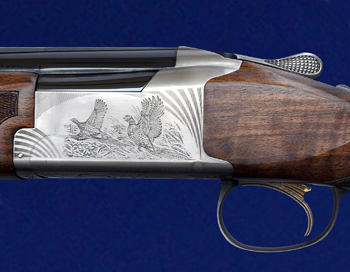Browning B725 Hunter shotgun review

Browning B725 Hunter shotgun
Manufacturer: Browning
Browning B725 Hunter shotgun.
Manufacturers have a habit of making cosmetic changes to guns and presenting them as new models.
However, this month’s test gun, while familiar in some respects and showing a clear heritage, is an entirely new gun with some interesting, indeed, novel features.
It is from the Browning stable and is called the 725. We are familiar with the 425/525 (and there has also been a very similar 625 available in the States) but this gun represents a new generation of Brownings.
It will be marketed in tandem with the 525 for the moment.
If I were to make a rough comparison, it would be between the Beretta Silver Pigeon on the 600 series action and the new Prevail and Perennia based on that firm’s new SV10 chassis.

From a distance you might be forgiven for thinking that there is not much that is different about the new Browning, but you would be mistaken.
The action is significantly lower (though it retains a full-width cross pin and the traditional locking/ bolting system of the Browning Superposed/B25).
The barrels are significantly lighter, too, not to mention back-bored (which means they are wider in bore diameter than the average 12″ though this feature is not original to the 725).
They have extended forcing cones and 3in (76mm) chambers proofed for steel shot. There is minimal “tromboning” at the muzzles to accommodate the new Invector DS (Double Seal) system chokes.
So, what is new about the barrels is that they are narrower at the muzzle and this innovation has moved the balance point back by approximately 10mm.
There is a new mechanical trigger system offering crisper, lighter pulls (about 3lb) and reduced trigger movement and lock time.

There is an inertia safety sear incorporated in the mechanism, too.
An In-Flex II hi-tech polymer recoil pad is not only exceptionally light, with excellent recoil absorption characteristics, but “non-stick”, too, and available in a variety of lengths (which allows for alterations to butt length with minimal work).
It is better shaped than many at its sole as well.
Aesthetically, the 725 has an action which is not only lower in profile but has reshaped shoulders and fences, and a remodelled top lever.
The Hunter is decorated with gamebirds and has some modernistic, radiused lines to the edges, reminiscent of a sunburst.
It is quite attractive, the birds are well enough done, and the adornments in good taste, but it would be more dramatic if the engraving were a little deeper.
Something like the embellishment on a Grade V Miroku would work really well, mind you, at this very reasonable price point, such refinement may not be possible.

The stock is made from good quality, quite dense walnut. It has a full pistol grip which is not excessively radiused (the Sporter has a palm swell but this is not a feature of the Hunter).
There is also a Schnabel fore-end with a subtle bill to its end, and a Deeley lifting-latch fore-end fastener.
Chequering is well cut and practical, offering good purchase.
Dimensions and stock form are good, and the oil finish is what most of us prefer.
TECHNICAL DATA
The most important change to the 725 is the trigger. Operating on a mechanical rather than inertia principle, it made the gun feel different in use to its predecessors.
A mechanical trigger is my preference in a game-gun as it is not ammunition dependent (you can use light loads without problems ? not always the case with inertia systems).
Trigger pulls are set in the game-gun (Hunter) in the region of 1.5kg and 1.8kg (1.4kg and 1.6kg in the Sporter).
The changes to barrel profile and chokes are significant.

Browning barrels have always been well made, but in Japanese-produced guns like this, with multi-chokes, they could be too heavy.
This is no longer the case. There is a significant weight reduction (improving balance and bringing it closer to the hinge pin).
And the new, long (80mm), DS (Double Seal) thin-wall chokes have threading at the muzzle end and brass sealing rings at the base to prevent gas seepage between chokes and barrel walls.
The chokes themselves are made from the same steel as the FN .50-calibre machinegun, so ought to be tough!
SHOOTING IMPRESSIONS
I tested this gun and its Sporter sibling at the Bodony estate west of Budapest, where nearly a thousand quality birds were shot on the first day and more than 600 on the second.
I prefer heavier guns, so did most of my shooting with the 30in Sporter rather than the 28in Hunter.
Using Winchester 32g Ranger cartridges, I downed 23 birds straight on one quite testing drive, albeit with a second barrel or two.
I found the 725 very natural to shoot with.

The 28in Hunter model, at just over 7lb, recoiled a little more than the 7lb 10oz, 30in Sporter, but this is a brilliant new design with improved trigger pulls and a very clever choke system with improved gas seal.
This is one of the best guns that I have shot at live game for a long time.
If you want something for high birds and sporting clays look no further.
Browning B725 Hunter
£1,850
Browning B725 Sporter
£1,895








